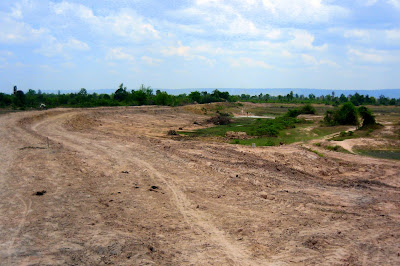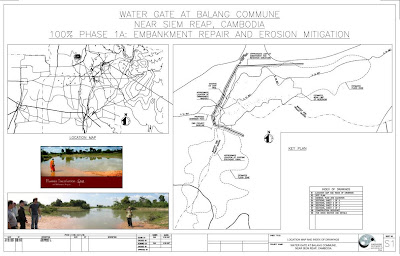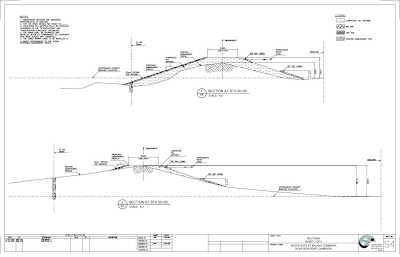This phase of the construction requires keeping a keen eye on the type of soil being used for the fill material. The borrow location is inside the basin and was predetermined from our first site assessment last November. CMAC had finished clearing that area a few weeks ago.


Matt taking a look at the excavated borrow area.
Bryse scooping up a bowl for sampling.
Soil can be good at one location, then bad a few feet later. Every time the excavator dumps a heap into the truck, we must check that soil. For example, in one location, a 7’ deep pit yielded nothing but very sandy soil. After rejecting this pit, another one was dug about 50 yards away to find the pre-approved sandy silty loam sitting 5’ below ground. Sandy silty loam is more available in abundance in this area.


One can see the layers of the soil. The first 1’to2’ is organic material, followed by 2’to3’ of fine sands, followed by the approved fine sandy silty loam.
A closer look, Bryse holding the sandy silt loam in the left, and sandy soil on the right.




The soil was stove dried in the field, and varying moisture content bags were made to develop an intuitive understanding of how the soil feels at different moisture content. Shown above are bags with 8%, 10%, 12%, and 14% moisture content.




A long day in the field is followed by a long session of soil classification based on the Unified Soils Classification System (USCS). This requires sieving through a #10, #40, and #200 sieve, followed by performing the plastic and liquid limit (aka Atterberg Limits).


The soils lab was set up at our friendly guesthouse’s patio area and on top of the bbq grill.




























 Doing KAP was a 4 people effort. Chai was focused on flying the kite, Tobias manned the remote transmitter, wiL constantly had to untangle all the knots (somehow you ALWAYS get knots), and Bryse to stand in every downward shot with a pvc pole pointing North for point of reference and scale of photo.
Doing KAP was a 4 people effort. Chai was focused on flying the kite, Tobias manned the remote transmitter, wiL constantly had to untangle all the knots (somehow you ALWAYS get knots), and Bryse to stand in every downward shot with a pvc pole pointing North for point of reference and scale of photo. Here's Chai feeding up the KAP unit. after a couple of trial and error, we figured out a strategy to get the unit up. attaching the unit too close to the kite causes difficult initial launching, since the wind at ground level is not usually as strong to lift the unit. launching the kite by itself for the initial 100' or so allows the kite to catch onto stronger winds above, hence, "locking" the kite up there. at this point, attaching the KAP unit to a newly tied knot will easily draw the entire unit up.
Here's Chai feeding up the KAP unit. after a couple of trial and error, we figured out a strategy to get the unit up. attaching the unit too close to the kite causes difficult initial launching, since the wind at ground level is not usually as strong to lift the unit. launching the kite by itself for the initial 100' or so allows the kite to catch onto stronger winds above, hence, "locking" the kite up there. at this point, attaching the KAP unit to a newly tied knot will easily draw the entire unit up.  Left to right: two local spectators, Tobias controlling the remote, Chai teasing the kite, wiL feeding the line.
Left to right: two local spectators, Tobias controlling the remote, Chai teasing the kite, wiL feeding the line.

















